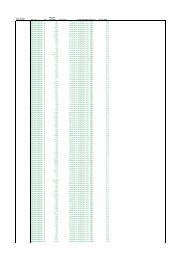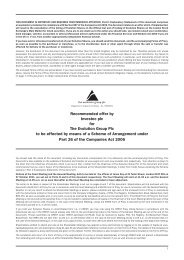Annual Report for the year ended 31 December 2008
Annual Report for the year ended 31 December 2008
Annual Report for the year ended 31 December 2008
Create successful ePaper yourself
Turn your PDF publications into a flip-book with our unique Google optimized e-Paper software.
shareholding of more than one half of <strong>the</strong> voting rights. The existence and<br />
effect of potential voting rights that are currently exercisable or convertible<br />
are considered when assessing whe<strong>the</strong>r <strong>the</strong> Group controls ano<strong>the</strong>r entity.<br />
subsidiaries are fully consolidated from <strong>the</strong> date on which control is transferred<br />
to <strong>the</strong> Group. They are deconsolidated from <strong>the</strong> date that control ceases.<br />
All intra-Group transactions and balances are eliminated on consolidation<br />
and consistent accounting policies are used throughout <strong>the</strong> Group <strong>for</strong> <strong>the</strong><br />
purposes of <strong>the</strong> consolidation.<br />
Investments in fund entities<br />
Where <strong>the</strong> Group is an investor and has at least significant influence over <strong>the</strong><br />
fund entities ei<strong>the</strong>r through a majority investment or through its role as investment<br />
manager, those fund entities are considered to be subsidiaries of <strong>the</strong> Group.<br />
b) Transactions with minority interests<br />
The Group applies a policy of treating transactions with minority interests as<br />
transactions with parties external to <strong>the</strong> Group. Disposals to minority<br />
interests result in gains and losses <strong>for</strong> <strong>the</strong> Group that are recorded in <strong>the</strong><br />
consolidated income statement. purchases from minority interests result in<br />
goodwill, being <strong>the</strong> difference between any consideration paid and <strong>the</strong><br />
relevant share acquired of <strong>the</strong> carrying value of net assets of <strong>the</strong> subsidiary.<br />
Business combinations<br />
The purchase method of accounting is used to account <strong>for</strong> <strong>the</strong> acquisition<br />
of subsidiaries as prescribed under iFrs 3, ‘Business combinations’.<br />
The cost of an acquisition is measured at <strong>the</strong> fair value of <strong>the</strong> identifiable<br />
assets given, equity instruments issued and liabilities or contingent liabilities<br />
incurred or assumed at <strong>the</strong> date of exchange, toge<strong>the</strong>r with any costs<br />
directly related to <strong>the</strong> acquisition. The excess of <strong>the</strong> cost of an acquisition<br />
over <strong>the</strong> Group’s share of <strong>the</strong> fair value of <strong>the</strong> identifiable assets, liabilities<br />
and contingent liabilities acquired is recorded as goodwill. if <strong>the</strong> cost<br />
of <strong>the</strong> acquisition is less than <strong>the</strong> fair value of <strong>the</strong> Group’s share of <strong>the</strong><br />
identifiable assets, liabilities and contingent liabilities of <strong>the</strong> subsidiary<br />
acquired, <strong>the</strong> difference is recognised immediately in <strong>the</strong> consolidated<br />
income statement as negative goodwill.<br />
Income recognition<br />
The Group follows <strong>the</strong> principles of iAs 18, ‘revenue recognition’, in<br />
determining appropriate revenue recognition policies. in principle, <strong>the</strong>re<strong>for</strong>e,<br />
revenue is recognised to <strong>the</strong> extent that it is probable that <strong>the</strong> economic<br />
benefits associated with <strong>the</strong> transaction will flow into <strong>the</strong> Group.<br />
a) Fee and commission income<br />
Fee and commission income includes transaction income, commission<br />
income, trail commission, placing commission, retainer income, initial<br />
commission and fees from asset management activities (including interest<br />
income on private client assets), net of payaway to independent Financial<br />
Advisers, introducers and self-employed half commission persons.<br />
initial commissions received from clients are capitalised, when received, in<br />
<strong>the</strong> Balance sheet, as deferred income. These amounts are amortised over<br />
<strong>the</strong> average holding period of five <strong>year</strong>s, <strong>the</strong> relevant period in which <strong>the</strong><br />
relationship between <strong>the</strong> commission earned (and paid away) and <strong>the</strong> assets<br />
under management to which such commissions relate is believed to exist.<br />
notes to tHe FinanCial statements CONTINuED<br />
FOR THE YEAR ENDED <strong>31</strong> DECEMBER <strong>2008</strong><br />
Fees and commissions are recognised in <strong>the</strong> income statement when <strong>the</strong><br />
related services are per<strong>for</strong>med and all legal conditions have been satisfied,<br />
and when considered recoverable.<br />
b) Fee and commission expenses<br />
Fee and commission expenses includes amounts paid to o<strong>the</strong>r third<br />
parties in connection with corporate finance fee income such as introduction<br />
fees. costs incurred in <strong>the</strong> normal course of executing commission<br />
transactions across our exchanges and settling through recognised<br />
networks are also included.<br />
initial commissions paid to advisors are capitalised, when paid, in <strong>the</strong><br />
Balance sheet as an asset. These amounts are amortised over <strong>the</strong> average<br />
holding period of five <strong>year</strong>s, <strong>the</strong> relevant period in which <strong>the</strong> relationship<br />
between <strong>the</strong> commission earned (and paid away) and <strong>the</strong> assets under<br />
management to which such commissions relate is believed to exist. The<br />
amortised amount appears within fee and commission expense.<br />
c) Trading income<br />
Trading income from market making and principal trading activities<br />
comprises all gains and losses from changes in <strong>the</strong> fair value of financial<br />
assets and liabilities held <strong>for</strong> trading, toge<strong>the</strong>r with any related dividend<br />
income on positions held. costs incurred in <strong>the</strong> normal course of executing<br />
trading transactions across our exchanges and settling through recognised<br />
networks are included within o<strong>the</strong>r administrative expenses.<br />
Derivative contracts relating to equity options and warrants received in lieu<br />
of corporate finance fees, which have been acquired at zero cost are initially<br />
accounted and measured at fair value on <strong>the</strong> date a derivative contract is<br />
entered into. This is included within trading income and subsequently measured<br />
at fair value with <strong>the</strong> gain or loss on re-measurement taken to <strong>the</strong><br />
consolidated income statement within trading income.<br />
d) O<strong>the</strong>r income<br />
o<strong>the</strong>r income includes fees <strong>for</strong> probate valuations and <strong>for</strong>eign exchange<br />
gains and losses resulting from <strong>the</strong> re-translation and settlement of <strong>for</strong>eign<br />
currency transactions and any dividend income on available-<strong>for</strong>-sale financial<br />
assets. interest income on segregated client money accounts which relates<br />
to evolution securities is included within this category.<br />
Operating leases<br />
rentals applicable to operating leases where substantially all <strong>the</strong> benefits<br />
and risk of ownership remain with <strong>the</strong> lessor are charged to <strong>the</strong> income<br />
statement on a straight line basis over <strong>the</strong> lease term.<br />
lease incentives are credited to <strong>the</strong> consolidated income statement and<br />
spread over <strong>the</strong> life of <strong>the</strong> lease.<br />
Exceptional items<br />
exceptional items are shown on <strong>the</strong> face of <strong>the</strong> consolidated income<br />
statement of <strong>the</strong> Group. The Group presents <strong>the</strong>m separately, in order to<br />
simplify comparability between different financial periods. An exceptional<br />
item is defined in terms of its size and/or nature. These do not arise from<br />
normal trading operations and may not be individually significant in size<br />
but in aggregate are worthy of separate disclosure.<br />
45






![2. Front continued [c87307] - The Evolution Group PLC](https://img.yumpu.com/19604468/1/184x260/2-front-continued-c87307-the-evolution-group-plc.jpg?quality=85)


